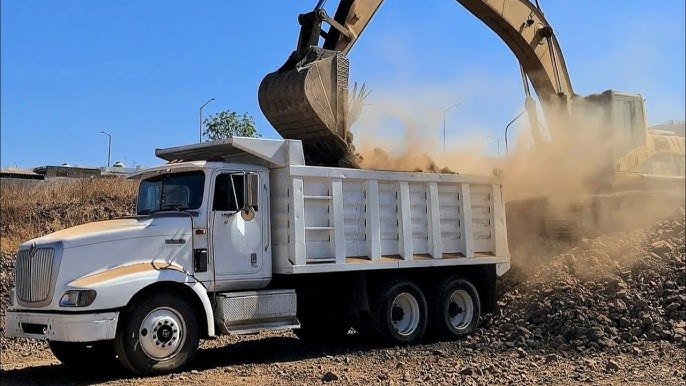Introduction
In the construction, mining, and infrastructure sectors, logistics are everything. Materials like gravel, dirt, sand, and demolition debris need to be moved quickly and efficiently—on time, on budget, and without delays. But hauling materials isn’t just about trucks on the road. It’s about coordination. And that’s where dump truck dispatch becomes essential.
Behind every successful hauling operation is a dispatcher—or dispatch system—working hard to schedule loads, assign drivers, track progress, and manage changes on the fly. Whether you operate a single truck or manage a fleet of 100, optimizing your dispatch process can save time, reduce costs, and enhance your service reputation.
This guide will break down everything you need to know about dump truck dispatch—from traditional methods to modern technology, best practices, and how to overcome common challenges.
🚧 1. What Is Dump Truck Dispatch?
Dump truck dispatch is the process of scheduling and managing dump truck operations. It involves assigning jobs to available trucks, determining routes, tracking progress, and handling communication between drivers and job sites.
Dispatching isn’t just about who gets which load—it’s a logistical coordination hub that includes:
- Assigning loads based on truck capacity and availability
- Ensuring delivery schedules align with job site needs
- Adjusting to real-time changes, delays, or weather issues
- Communicating instructions clearly with drivers
- Maintaining records for billing and performance tracking
Dump truck dispatch serves as the operational backbone for companies that haul construction materials, aggregates, asphalt, soil, or refuse.
🛠️ 2. The Dispatcher’s Role: More Than Just Scheduling
In a traditional operation, the dispatcher is a central figure—usually someone with a radio, clipboard, and deep knowledge of local routes and job sites. But the role extends beyond just sending trucks from point A to point B.
Key Responsibilities of a Dispatcher:
- Load Planning: Matching the right truck to the right job (based on type, size, weight limits).
- Route Optimization: Planning the most efficient routes to save time and fuel.
- Driver Management: Coordinating availability, breaks, and compliance.
- Communication Hub: Relaying job updates, weather changes, or delays.
- Problem Solving: Adjusting the schedule when things go off course.
- Documentation: Tracking loads, hours, and performance metrics.
A great dispatcher doesn’t just move materials—they manage people, time, and money. And as operations grow, many companies move from manual systems to digital platforms to scale efficiently.
📋 3. Common Challenges in Dump Truck Dispatch
Dispatching dump trucks may seem straightforward, but in reality, it involves managing a complex web of moving parts. Here are some of the most frequent pain points:
🚫 Unavailable Trucks
High demand, unexpected breakdowns, or no-shows can throw a schedule into chaos.
📞 Miscommunication
Drivers may miss instructions or arrive late due to unclear directions or missing information.
🛑 Delays on Job Sites
A late loader, blocked access, or changes in material quantity can create a ripple effect.
⚖️ Overloaded or Underloaded Trucks
Inefficient load planning can lead to compliance issues or missed hauling targets.
💸 Inefficient Routes
Without optimization, drivers may waste fuel or time on unnecessary detours.
These issues not only impact productivity but also damage client relationships and reduce profits. The solution lies in better planning—and better tools.
🖥️ 4. Technology in Modern Dump Truck Dispatch
With advances in logistics technology, many hauling companies are ditching whiteboards and spreadsheets in favor of automated dump truck dispatch systems.
Features of Digital Dispatch Platforms:
- Real-time GPS tracking of trucks and loads
- Digital ticketing and load documentation
- Mobile apps for drivers to receive and confirm jobs
- Drag-and-drop scheduling interfaces
- Automatic notifications for clients and drivers
- Integration with accounting and time-tracking software
By using dispatch software, companies can improve scheduling accuracy, reduce idle time, and provide clients with live updates on delivery progress.
📲 5. How Dispatch Software Works
Most modern dispatch systems are cloud-based and accessible from both desktop and mobile devices. Here’s a quick breakdown of how they streamline the dispatch process:
Step-by-Step Workflow:
- Create a Job Order – Input pickup/drop-off locations, materials, timeframes.
- Assign Trucks – Match available drivers and vehicles to jobs.
- Dispatch Notification – Drivers receive job details via app or text.
- Track in Real-Time – Monitor driver location, load status, and ETA.
- Receive Confirmation – Digital tickets, photos, and signatures confirm delivery.
- Generate Reports – Easily pull data for billing, performance, or audits.
Everything is stored digitally, eliminating lost paperwork and making operations more efficient.
📦 6. Types of Hauling Jobs That Rely on Dispatch
Dump truck dispatch applies across a wide range of job types and industries:
- Construction Sites – Dirt, concrete, debris removal or delivery of fill materials.
- Road Work Projects – Asphalt delivery, milling transport, or aggregate hauling.
- Landscaping Jobs – Sand, mulch, stone, and topsoil delivery.
- Demolition Projects – Hauling away heavy debris and construction waste.
- Municipal Work – Snow removal, sand/salt delivery, and flood clean-up.
Each of these jobs has unique timing, safety, and logistical needs—which is why streamlined dispatching is so critical.
📈 7. Benefits of Optimizing Dump Truck Dispatch
Whether you upgrade your process with software or refine your manual system, there are measurable benefits to optimizing dispatch:
🔹 Increased Efficiency
Better scheduling means more loads moved per day.
🔹 Lower Fuel Costs
Route optimization minimizes mileage and idle time.
🔹 Happier Clients
On-time deliveries and better communication lead to higher satisfaction.
🔹 Fewer Mistakes
Automated instructions reduce human error.
🔹 Scalable Operations
Efficient dispatching allows you to grow your fleet or client base without adding chaos.
In a competitive industry, these advantages translate to higher margins and stronger reputation.
🚛 8. Best Practices for Effective Dispatching
Regardless of your system, following these proven practices will help streamline operations:
✅ Use Load Tracking Tools
Whether it’s GPS hardware or an app, knowing where your trucks are prevents guesswork.
✅ Confirm Job Details
Misunderstandings are costly. Confirm addresses, material types, and special instructions in writing.
✅ Build Driver Trust
A good dispatcher builds rapport with drivers—clear communication and respect go a long way.
✅ Monitor Performance
Track time per load, delays, and driver metrics to identify areas for improvement.
✅ Stay Flexible
Weather, traffic, and job site issues happen. Always have a Plan B (and C).
Dispatching is part art, part science—data helps, but experience and intuition are just as important.
📊 9. Key Metrics to Track in Dispatch Operations
To evaluate and improve your dump truck dispatch system, track the following KPIs (Key Performance Indicators):
- Loads per day/truck
- On-time delivery rate
- Idle time
- Average time per round trip
- Fuel consumption per load
- Driver utilization rate
- Client satisfaction scores
These metrics provide insight into how efficiently your fleet is operating—and where improvements can be made.
💡 10. Is Outsourced Dispatching an Option?
Yes. Some smaller hauling companies or owner-operators hire third-party dispatchers or use dispatching services. These services often charge a fee or percentage of each load handled.
Pros:
- No need to hire a full-time dispatcher
- Access to experienced logistics professionals
- Often includes load sourcing and client communication
Cons:
- Less control over operations
- Additional costs
- Reliance on third-party systems
This can be a good option for businesses just starting out or those wanting to scale without adding internal staff.
✅ Conclusion
Efficient dump truck dispatch is the cornerstone of any successful hauling operation. From matching drivers to jobs and optimizing routes to tracking performance in real time, the dispatch function holds the keys to productivity, profitability, and client satisfaction.
Whether you’re operating one truck or 100, investing in better dispatch systems—whether through software, training, or smarter processes—pays dividends quickly. And in an industry where timing, accuracy, and service matter most, a smart dispatch strategy can be the competitive edge that sets your company apart.
If you’re looking to grow, streamline, or modernize your operations, start by looking at your dump truck dispatch workflow. Because when dispatch is dialed in, everything else falls into place.
For More Information, Visit Dotmagazine









